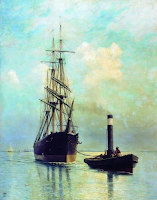Albert Bierstadt's Artistic Odyssey - Painting the American West Through His Eyes

Albert Bierstadt, born in Solingen, Prussia, in 1830, moved to the United States with his family at the age of one. He played a pivotal role in the Hudson River School, a group of American landscape painters, and was known for his contributions to the luminist movement. Bierstadt's journeys through the American West, particularly during the Westward Expansion, became the catalyst for his iconic paintings that celebrated the untouched beauty of the landscapes.

Exploring the Rockies
Bierstadt's exploration of the Rockies was a visual feast captured on canvas. The artist's journey into the heart of these majestic peaks allowed him to witness and depict the sublime landscapes. "Among the Sierra Nevada Mountains" and "The Rocky Mountains, Lander's Peak" stand as testaments to his ability to convey the awe-inspiring scale and beauty of the Rockies. His detailed observations, coupled with a keen understanding of light and shadow, brought these scenes to life.

Serene Valleys of Yosemite
Yosemite Valley became a muse for Bierstadt, inspiring some of his most renowned works. The artist's fascination with the serene valleys, waterfalls, and towering cliffs is evident in paintings like "Looking Down Yosemite Valley" and "California Spring." Bierstadt's portrayal of Yosemite goes beyond mere representation; it reflects a deep emotional connection and a commitment to conveying the spiritual essence of the landscape.

Profound Impact
Bierstadt's journeys had a profound impact on both his artistic career and the broader artistic landscape of the 19th century. Through his paintings, he shaped the perception of the American West, drawing attention to its untamed beauty. His influence extended beyond the canvas, contributing to the popularization of Western landscapes and influencing subsequent generations of artists who sought to capture the sublime in nature.
Frequently Asked Questions:
Q1: Why did Bierstadt focus on the American West in his paintings?
A1: Bierstadt was drawn to the unexplored and pristine landscapes of the American West. His paintings played a crucial role in fostering public interest in the region during the Westward Expansion, serving as both artistic expressions and promotional tools.
Q2: How did Bierstadt's European training influence his American landscapes?
A2: Bierstadt's training in Düsseldorf, Germany, imparted a meticulous attention to detail and a mastery of luminist techniques. This European influence, combined with his experiences in the American West, created a unique blend in his art.
Q3: Which Bierstadt painting is considered his masterpiece?
A3: While opinions may vary, "Among the Sierra Nevada Mountains" is often regarded as one of Bierstadt's masterpieces. It showcases his ability to capture the grandeur, luminosity, and emotional depth of the American West.

Conclusion:
Albert Bierstadt's artistic odyssey through the American West encapsulates the untamed beauty of the 19th-century landscapes. His luminist techniques and meticulous details immortalize the profound impact of his journeys, inviting us to experience the untouched grandeur of the West.
Read more about Albert Bierstadt
Albert Bierstadt - A Brush with the Sublime in American Landscapes
Albert Bierstadt's sublime landscapes, a 19th-century American frontier odyssey in paint. Capturing the essence of the West with grandeur and beauty.
Illuminating Nature - Albert Bierstadt's Luminist Techniques Unveiled
Dive into Albert Bierstadt's luminist world, revealing his mastery of light and meticulous details, illuminating nature with radiant brilliance.
Drawing Class - 9821920746





























